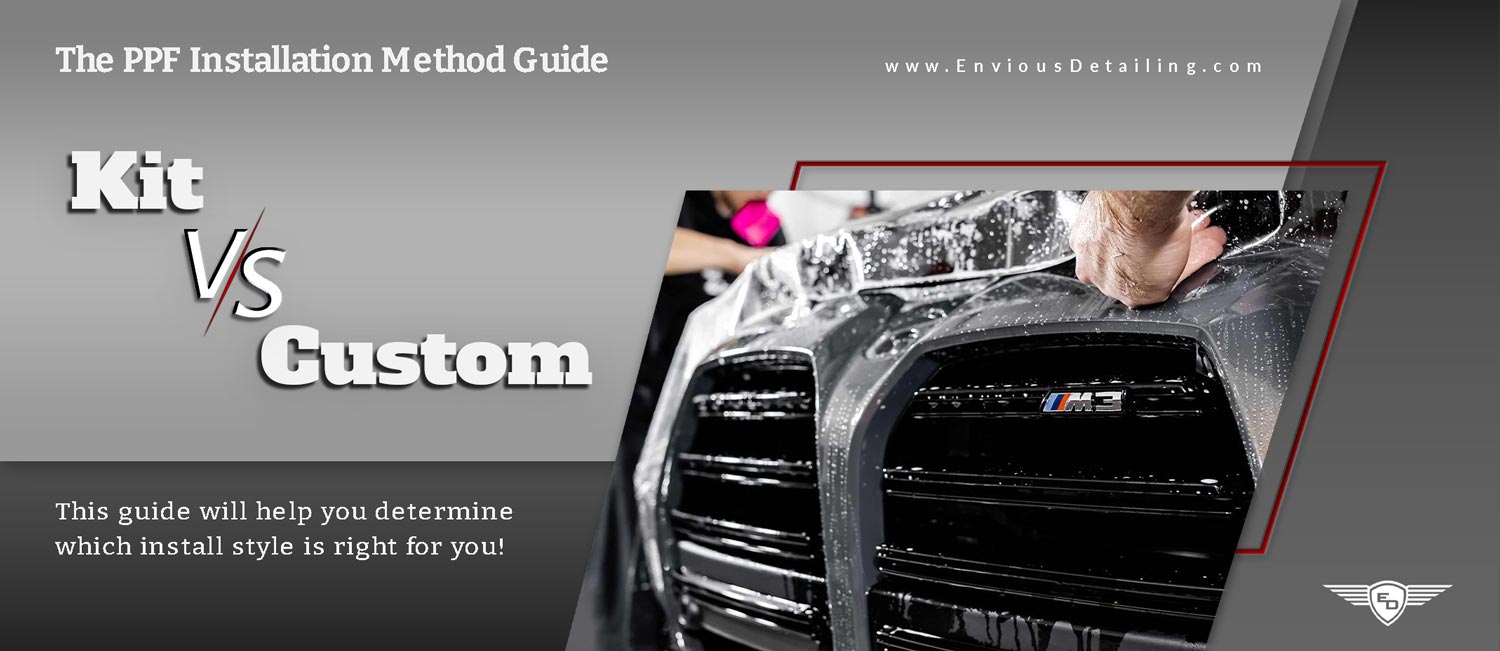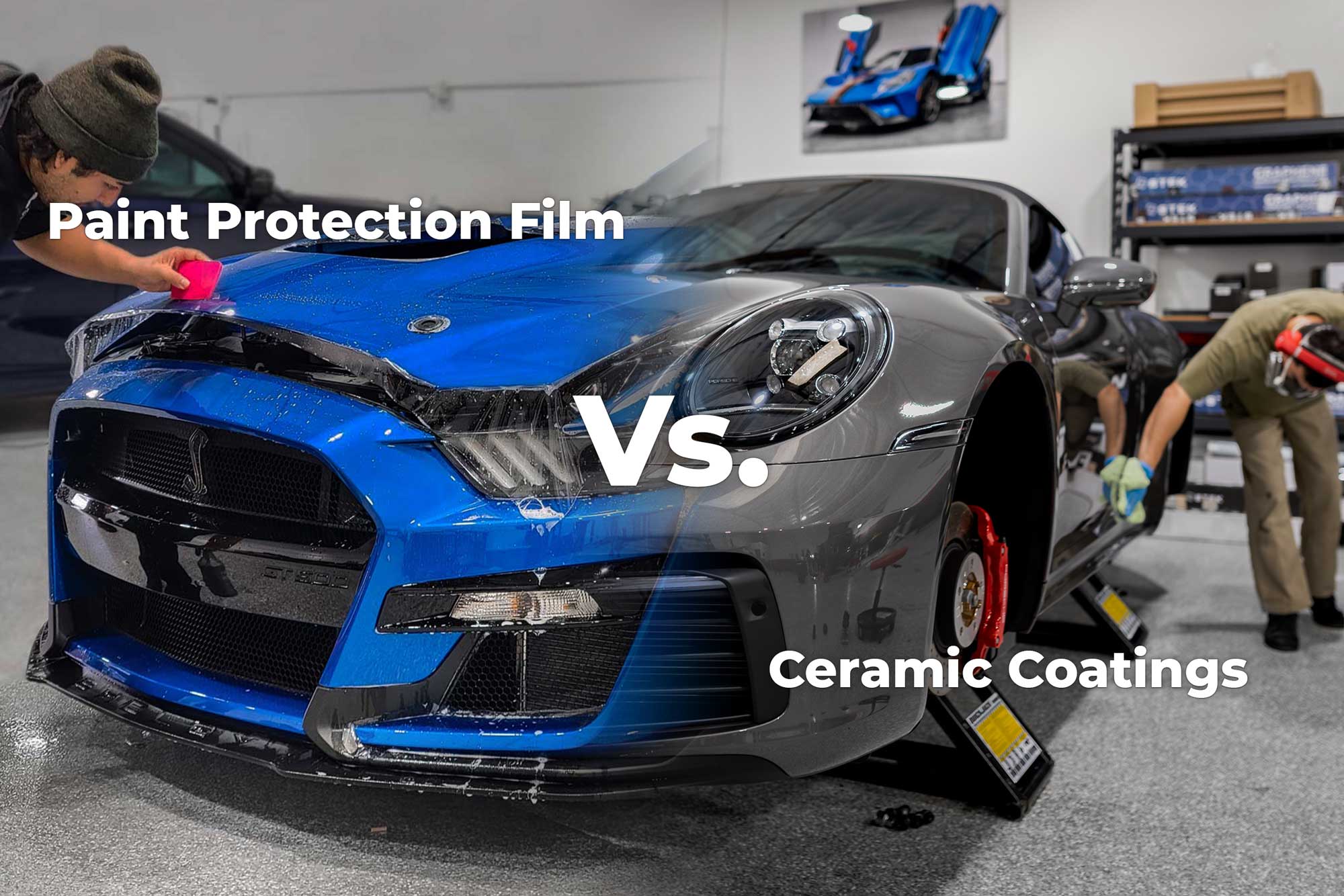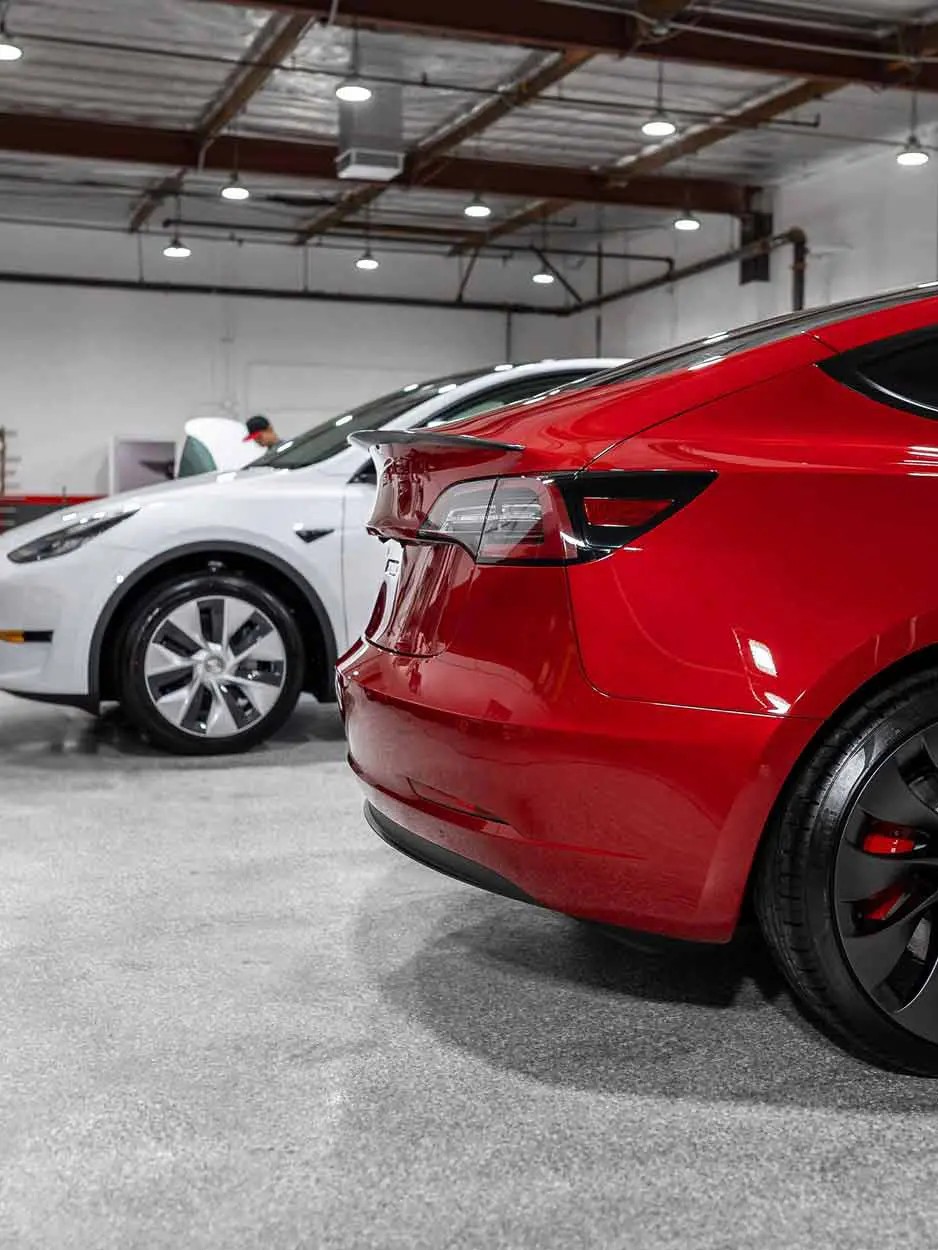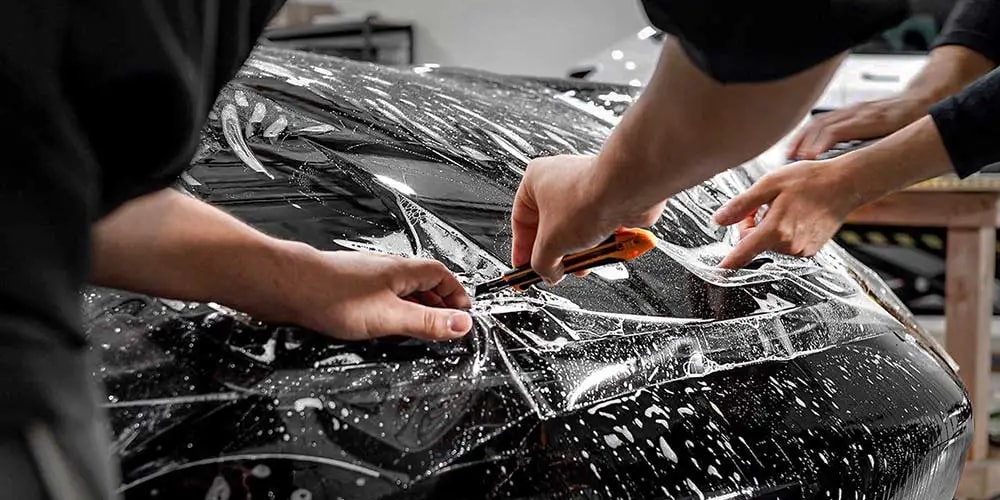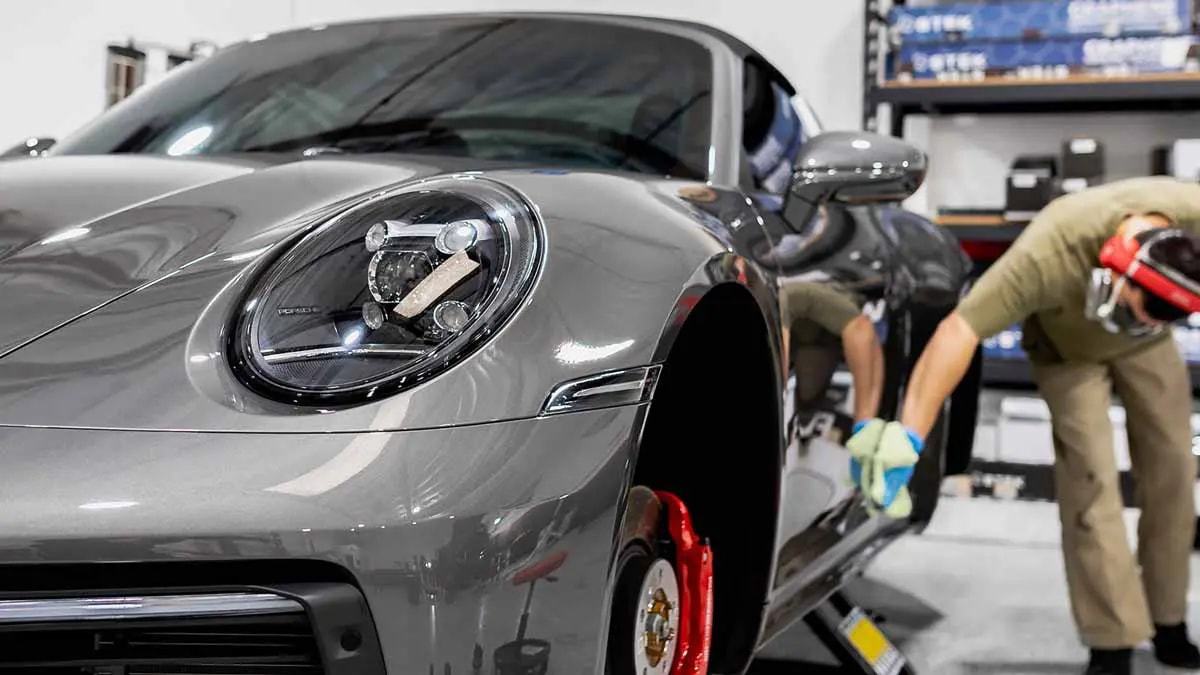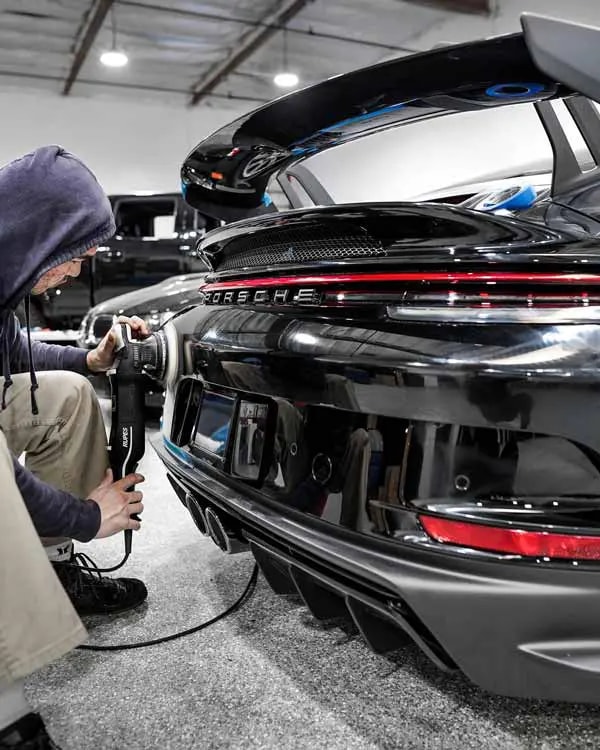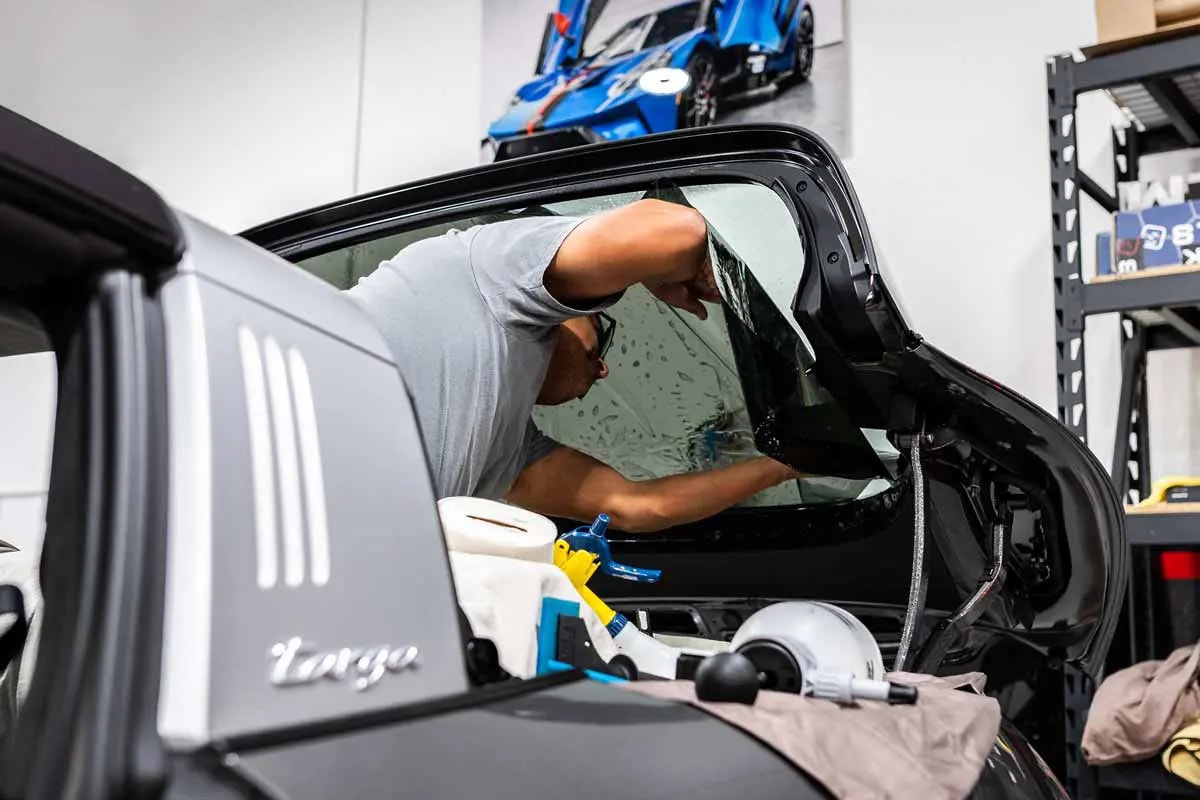If you're a car owner in Southern California, you know how difficult it can be to keep your car looking its best. From our sandy beaches to congested highways, our cars are constantly exposed to hazards that can damage the paint and decrease their value.
That's why many car owners turn to Paint Protection Film (PPF) as a solution to protect their investment! PPF is a clear, durable film that's applied to a car's paint to protect it from chips, scratches, and other types of damage.
There are two main methods for installing PPF: the Kit (pre-cut pattern) PPF install, and the custom (bulk hand-trimmed) PPF install.
This blog post will explore the differences between the two methods and help you decide which is best for your car. We'll be able to cover questions such as...
- What are the main differences?
- Are there any risks involved with either installation?
- Which install method gives a better result?
- Why are the installation methods priced differently?
- What should I consider when making my decision?
We'll have plenty of example images for your reference throughout this article, but if you prefer video content, we have a video dedicated to this guide!
What is Paint Protection Film (AKA Clear Bra)?
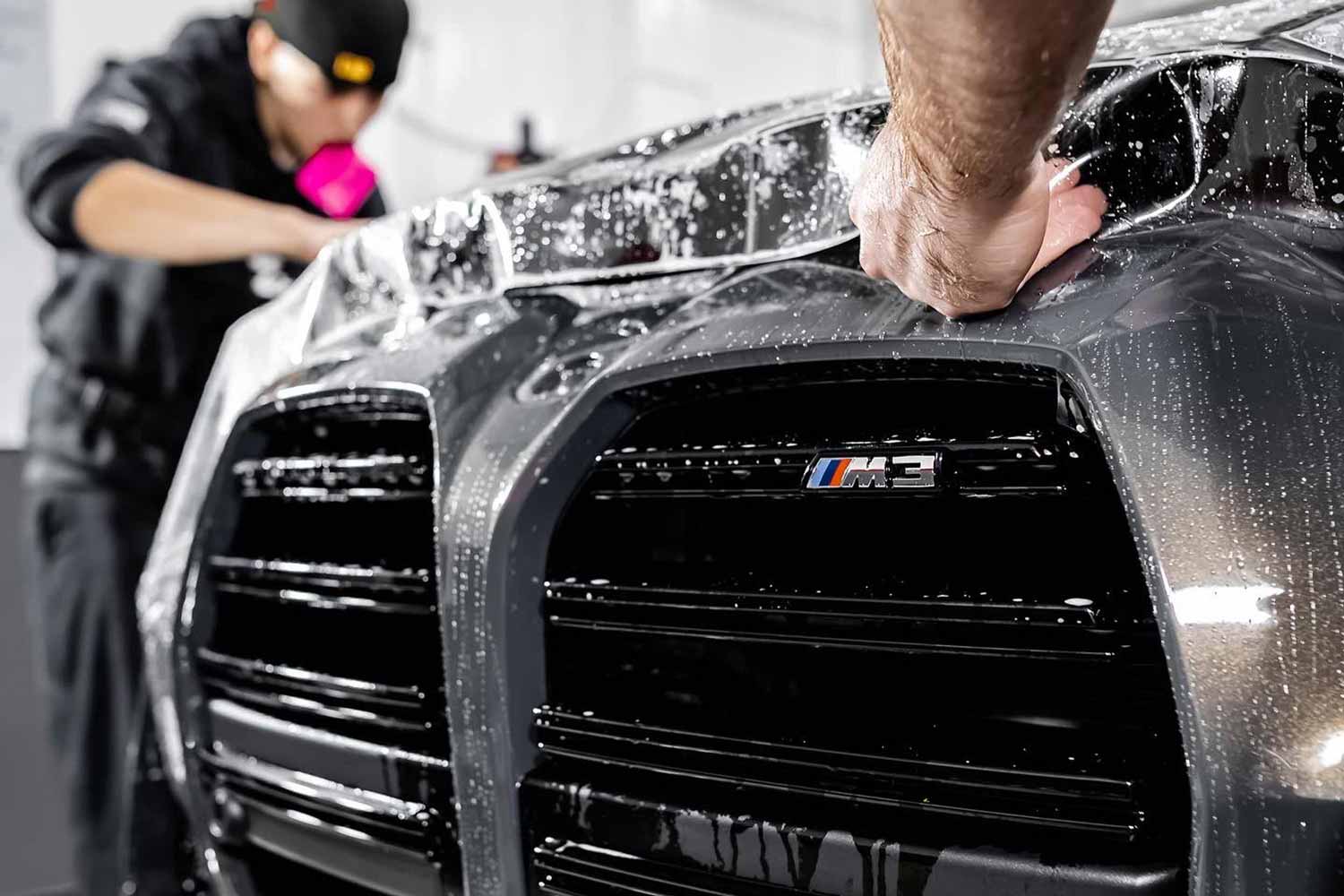
Paint Protection Film (PPF) is also known as a "Clear Bra" because of its ability to protect your car's paint without changing its appearance. Clear Bra is a transparent film applied to your car's painted surfaces to protect it from scratches, chips, and other types of damage.
PPF is made from a thermoplastic urethane material that's tough and resistant to abrasions, chemicals, and UV damage. The primary goal of this film is to protect your car from environmental hazards like bird droppings and tree sap, in addition to road debris that can cause damage to your car's paint.
One of the best things about Clear Bra is that it's virtually invisible so it won't change your car's appearance. You can apply it to specific areas of your vehicle, such as the high-impact areas (i.e., your front bumper), or you can cover the entire car for maximum protection. You can click here to see our various package options.
The Paint Protection Film installation method, the experience of the installer, and the type of PPF used dramatically impact the end product's appearance. Once you're confident with the expertise of the installer and the materials used for your vehicle, it will come down to deciding between a Kit (Pre-Cut Pattern) Install or a Custom (Bulk Hand-Trimmed) Install.
You will likely also stumble upon Ceramic Coatings when looking for protection options. Ceramic Coatings are also an excellent option for protection, but it is vastly different than Paint Protection Film. Here we broke down the differences between the two.
Overall, Clear Bra is a smart choice for Southern California car owners who want to protect their investments and keep their cars looking great for years. Being transparent and highly durable, PPF is the best protection option for anyone who wants to avoid going to the body shop and keep their paint looking pristine.
What are the 2 PPF Installation Methods?
Overview of Kit (Pre-Cut Pattern) Installation Method
The Kit installation utilizes pre-made patterns that are designed to fit precisely on the various panels of your vehicle. We have an extensive database of vehicle patterns, and it is more than likely that your car will already have a pattern designed. Each pattern is cut precisely using our in-house cutting machine, AKA a plotter. These patterns are then carefully installed on your vehicle.
The Kit installation is intended to be easier for the installer as it does not warrant vehicle disassembly to install accurately. This installation is much easier, less time-consuming, and, thus, less expensive.
Overview of Custom (Bulk Hand-Trimmed) Installation Method
The Custom installation involves using a larger piece of film and overlapping the edges of each panel. The edges and corners are then hand-trimmed to fit the specific contours of each panel.
This method requires a high level of skill and expertise, as the film needs to be cut and shaped by hand to fit the curves and edges of your car's body. This method provides a far more seamless and precise fit than the kit installation but is far more time-consuming.
The Custom install is the installation method that we are known for at Envious Detailing. In this installation, our experienced technicians perform advanced disassembly of the vehicle (removing bumpers, headlights, cameras, etc.) to ensure we have access to cover all edges and corners. There are limitations, but we push these limits with the expectation of a higher-quality installation.
Overview of Kit vs. Custom
Ultimately, the method you choose will depend on your budget, the level of precision you're looking for, and the installer's expertise. Choosing a reputable installer with experience with both methods is vital to ensure that your PPF is applied correctly and effectively. There is always the potential for damaging a vehicle, and you must choose a trusted installer with a track record of adhering to a high moral standard and principles of integrity in case anything goes awry.
Both methods have their advantages and disadvantages. The Kit installation is typically faster and less expensive than a Custom installation, but it won't provide as precise of a fit. On the other hand, Custom installation offers a far more precise fit but may require more time and expense.
Let's dive a little deeper, shall we?
What is the Kit (Pre-Cut Pattern) PPF Installation?
The Kit installation method for Paint Protection Film (PPF) uses pre-cut patterns designed to fit specific makes and models of cars.
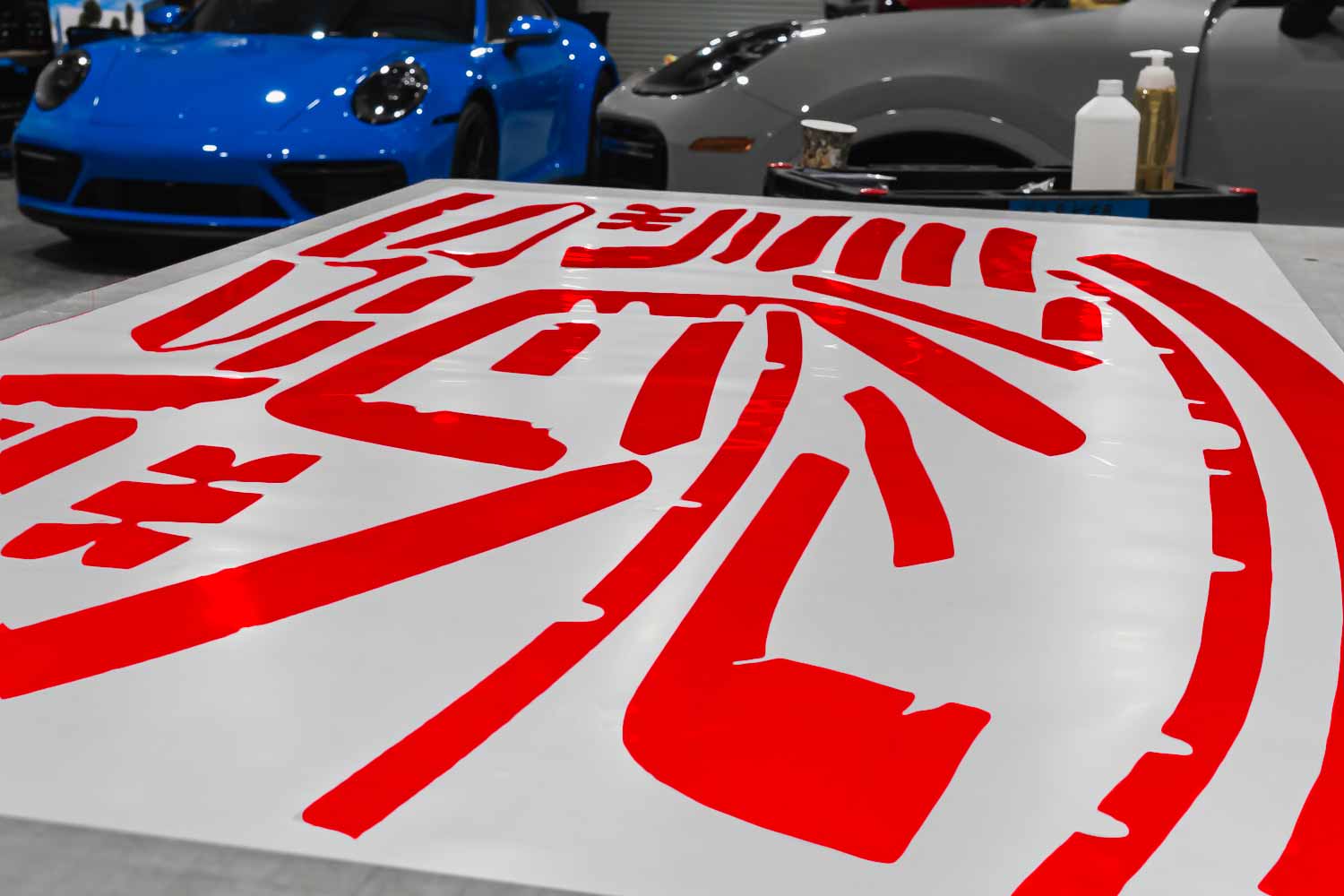
The Installation Process [Kit Install]
Prepping the car
1. The first step of any PPF installation is to thoroughly clean and decontaminate the surfaces where the PPF will be applied. Any dirt, dust, or debris can get trapped under the film, so ensuring the car is as clean as possible is crucial.
2. To do so, we perform our wash, clay treatment & chemical paint decontamination process. The initial wash strips the surface of any dirt or debris sitting on top of the paint. The clay treatment removes all of the contaminants embedded in the clear coat. The final measure of this process is the use of Supreme Detail Supply's Iron Remover, which breaks down any excess metal contaminants.
3. The panels receiving PPF are then polished to ensure they have the best surface for the PPF to adhere properly. We wash the vehicle one final time to remove any polishing material. All of the panels are then dried and wiped with a prep solution.
Applying the PPF
1. While prepping the vehicle, we cut the pattern of each panel. The PPF is fed through a machine known as a plotter which makes precise cuts explicitly tailored to your car's make and model.
2. Once the prep is complete, the PPF is applied in sections using the pre-cut patterns. Each section is carefully aligned and applied to the car's surface using a squeegee to remove air bubbles and adhere the PPF to the panel.
3. The PPF will wrap (cover) some edges while leaving others exposed. All corners will be exposed, as capping a corner requires excess film and hand-trimming. The images below show the exposed edges.
Final inspection
1. After installing a section, the installer inspects the entire panel to ensure the PPF is free of any defects and aligned correctly.
2. The installation is left alone to dry. Once it has had adequate time to dry out, the installer inspects the film again and addresses any concerns.
3. Our installations must meet a strict quality control inspection to ensure we always uphold our quality standards.
The Advantages [Kit Install]
There are a few advantages of choosing a Kit Installation:
Faster Installation Time
Because the patterns are pre-cut, kit installation typically takes less time than other installation methods. This means you can get your car back on the road and enjoy the benefits of PPF sooner.
Lower Cost
Kit installation is generally less expensive than other installation methods, making it an excellent option for car owners who want to protect their car's paint without spending a lot of money.
No Disassembly
While we have highly trained and experienced technicians, there is always the risk of causing damage to a vehicle during disassembly. We are not perfect, and sadly, accidents have happened. Without disassembly, there is less risk of damaging a part during the PPF process.
However, as mentioned previously, we solely operate on principles of integrity and transparency. If an accident were to occur, we always inform our clients, provide a solution, and offer our sincere apologies.
The risk of damage leads us back to the previous note that it is imperative to choose a trusted installer with a track record of adhering to a high moral standard and principles of integrity.
The Disadvantages [Kit Install]
While kit installation is a popular method for installing Paint Protection Film (PPF), it has some potential drawbacks. Here are some of the main disadvantages of Kit PPF installation:
Exposed Edges & Corners
The Kit Installation method utilizes the computer cut pattern, which outlines each panel and leaves edges and corners exposed. Not only can you see the film line (easier to see on lighter colors), but this leaves the edges and corners vulnerable to damage.
The image below shows Paint Protection Film on a Tesla Model 3 Fender. This was done to demonstrate how the edges and corners are exposed.
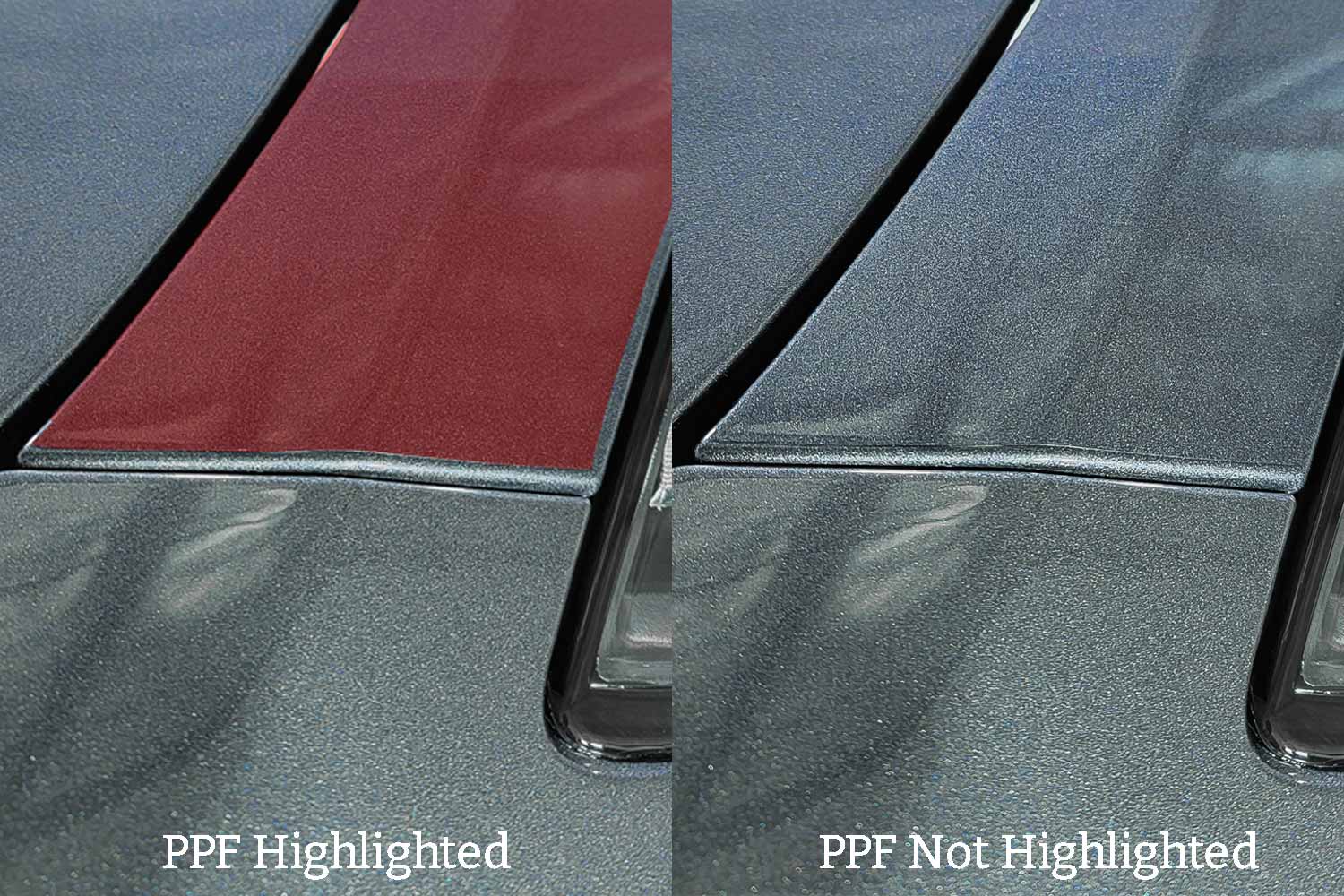
Not too long ago, a potential client stopped by the shop for an estimate. He had a Kit PPF Installed on his Ford Mustang GT500 at another shop, and during an inspection of the vehicle, we noticed significant damage to the paint in the areas the PPF did not cover. This example is shown in the image below, demonstrating the disadvantage of exposed edges and corners.
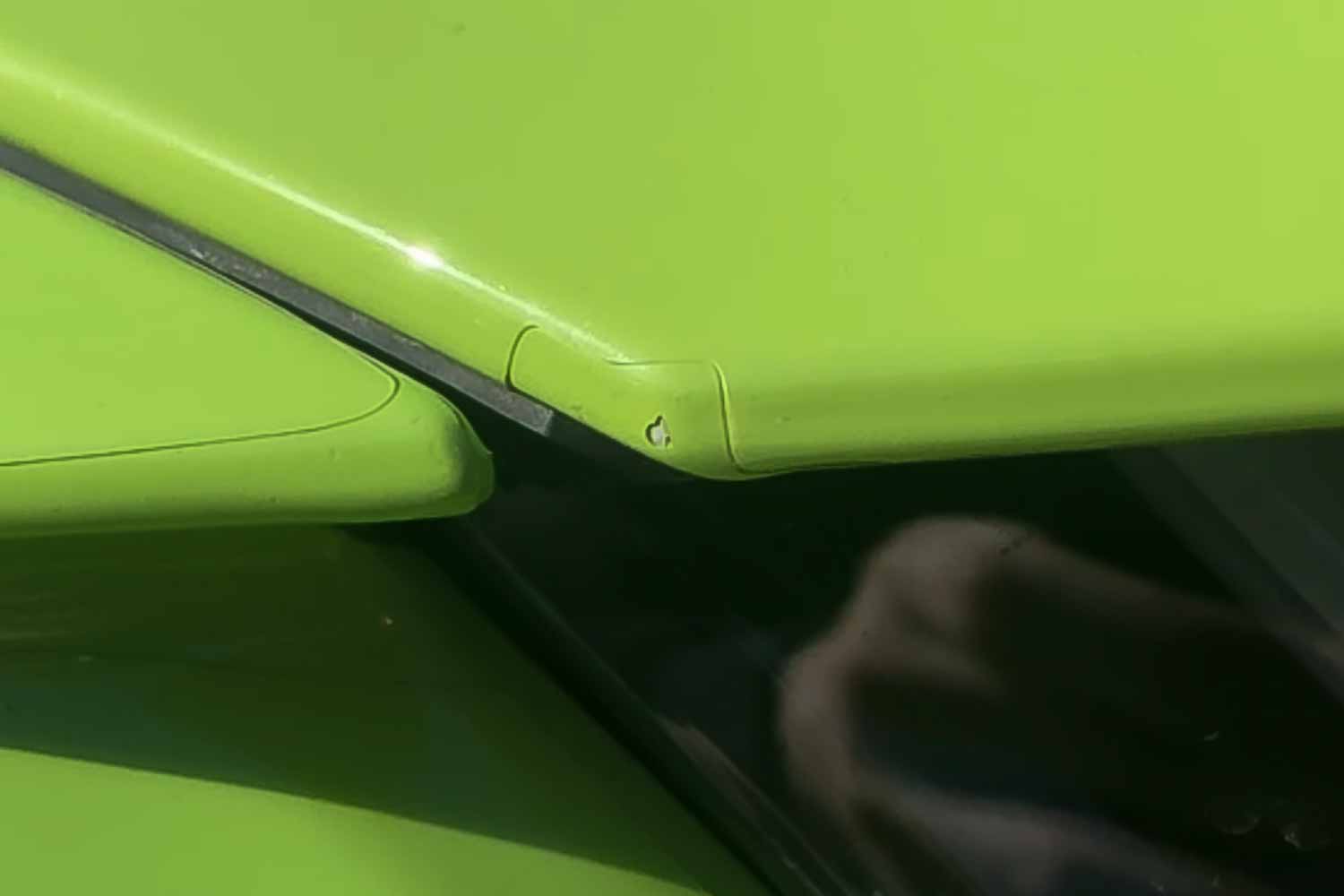
Seams to Relieve Tension
Some parts of a car's body have complex curves that can cause the film to have issues adhering well. If a panel creates too much tension in the film, the pattern may include a relief cut to make it easier to install and ensure the film properly adheres. That seam can be unsightly and varies from car to car/panel to panel.
When should you choose a Kit (Pre-Cut Pattern) PPF Install?
Budget Conscious
Everyone is working within their budget. While Paint Protection Film can save you a lot of time, money, and headache in the future, PPF is not a cheap protection option. A Kit installation is an excellent option for those looking for a less expensive way to protect their investment.
If budget is still a concern, Ceramic Coatings offer environmental protection! Just be aware that Ceramic Coating cannot provide the same protection capacity as Paint Protection Film.
Dark-Painted Vehicles
The exposed edges and corners of Paint Protection Film leave behind a visible line. However, this line is much harder to see when it is on a dark surface, specifically black. If you have a white or light-colored vehicle, we do not recommend going with a Kit Installation for various reasons, including the apparent lines.
Solely concerned about protection
If you are not bothered by seeing the lines of the exposed edges and corners on your car, then by all means, go with the Kit! The main concern with Paint Protection Film is that it, well, protects. So, if you're okay with seeing that you have PPF on the car from a few feet away, save some money and go with the Kit.
What is the Custom (Bulk Hand-Trimmed) PPF Installation?
The Custom installation method for Paint Protection Film (PPF) is a much more complex and time-consuming process. The installers disassemble the vehicle to allow greater access around the panel gaps. Once disassembled, a larger piece of film is extended over each panel's edges and corners. This film is then hand-trimmed to conform around the panel. This method allows for wrapped corners and edges and will provide the most seamless installation possible.
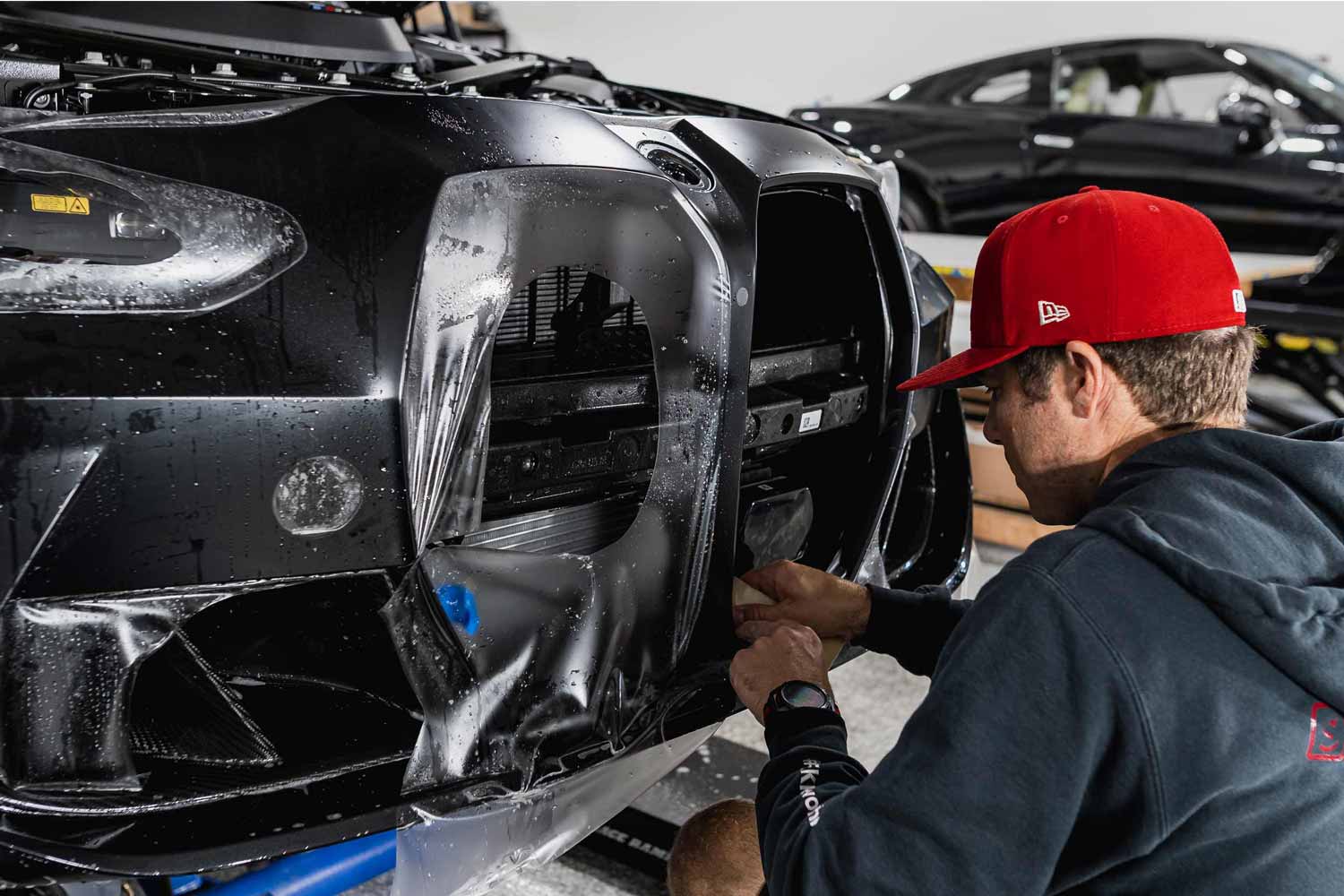
The Installation Process [Custom Install]
Prepping & Disassembly
1. The first step of any PPF installation is to thoroughly clean and decontaminate the surfaces where the PPF will be applied. Any dirt, dust, or debris can get trapped under the film, so ensuring the car is as clean as possible is crucial.
2. Although disassembly varies from car to car, we often disassemble specific panels of the vehicle before washing to ensure we remove all of the trapped dirt and debris from underneath these panels.
3. We then perform our wash, clay treatment & chemical paint decontamination process. The initial wash strips the surface of any dirt or debris sitting on top of the paint. The clay treatment removes all of the contaminants embedded in the clear coat. The final measure of this process is the use of Supreme Detail Supply's Iron Remover, which breaks down any excess metal contaminants.
4. The panels receiving PPF are then polished to ensure they have the best surface for the PPF to adhere properly. We wash the vehicle one final time to remove any polishing material. All of the panels are then dried and wiped with a prep solution.
Applying the PPF
1. Depending on the panel, we may use a single sheet of PPF (known as a bulk install) or extend the edges of a pattern. When a pattern is used, it is extended significantly to fully wrap edges and corners, which must then be hand-trimmed to conform to the panel accurately.
2. Each section is applied to the car's surface using a squeegee to remove air bubbles or wrinkles.
3. For specific panels, such as bumpers, we will remove the bumper, disassemble the body (remove vents, lights, etc.) and replace the bumper so we can install the PPF without the limitations of those internal pieces. Once the film is installed, we will remove it again, reinstall the trim pieces, and reinstall the full bumper.
4. The PPF will wrap the edges, cap the corners and provide as seamless an install as possible. The results of the Custom installation are shown in the images below.
Final inspection
1. After installing a section, the installer inspects the entire panel to ensure the PPF is free of any defects and aligned correctly.
2. The installation is left alone to dry. Once it has had adequate time to dry out, the installer inspects the film again and addresses any concerns.
3. Our installations must meet a strict quality control inspection to ensure we always uphold our quality standards.
The Advantages [Custom Install]
While the Kit installation method for Paint Protection Film (PPF) can be a good option in many cases, the Custom installation offers several advantages that make it a popular choice for our clients. The Custom install is the installation we're known for!
Here are some of the main advantages of custom PPF installation:
Virtually Invisible Protection
While it's imperative to protect your paint, you shouldn't have to make any sacrifices on appearance - that's why you're protecting it in the first place! Whether you're protecting an ultra-rare exotic or your new daily driver, the Custom install wraps edges and caps corners, meaning only a trained eye can tell it has PPF!
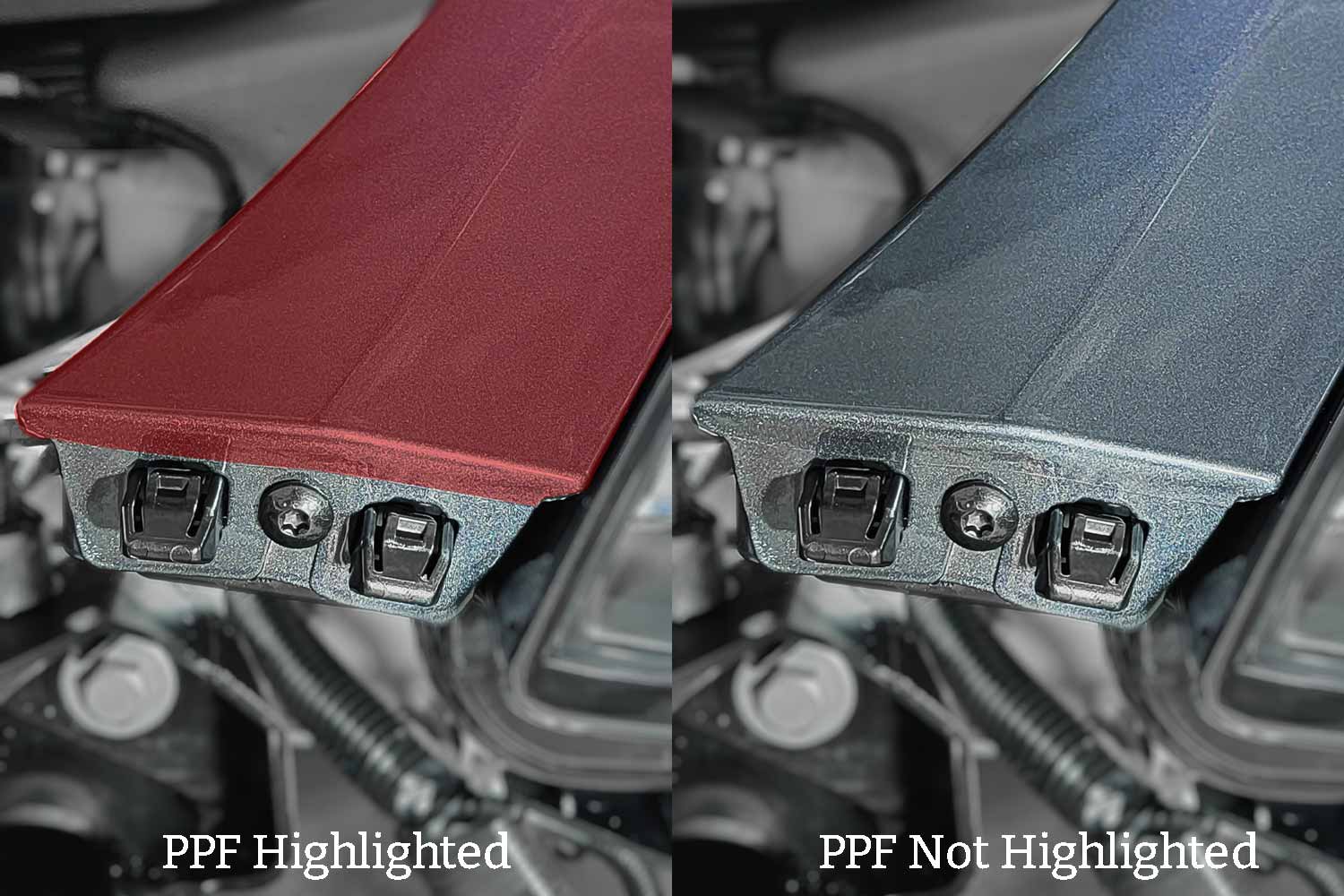
Greater Protection
The Kit installation leaves edges and corners exposed, waiting to be hit with debris from the road or left to the sun's mercy. A prime example was shown previously in the Disadvantages of a Kit Install section, where rocks damaged the exposed edges of a Mustang GT500.
On the other hand, the Custom installation provides far greater coverage and ensures that all edges and corners are protected.
Customizable Coverage
With the Custom PPF Installation, you can choose which areas of your car's body to protect. This can include areas not covered by pre-cut kits, such as an extended rear quarter panel.
For example:
The extended rear quarter panel example can be seen on the BMW M2 below. There is no Kit pattern for this type of work, but it can be custom-made to match our client's request. This piece allows for far greater coverage on the rear quarter while minimizing the edges shown. The edge of the film follows the body panel, which does a good job of hiding the edge.

A Custom installation is also essential for any custom parts or classic cars that do not have a pattern made.
The Disadvantages [Custom Install]
While the Custom Installation of Paint Protection Film (PPF) has several advantages over pre-cut kits, there are some potential drawbacks.
Here are some of the main disadvantages of custom PPF installation:
Longer Installation Time
The Custom PPF installation can take longer than pre-cut kit installation, as each piece of film must be carefully hand-trimmed to fit your car's unique shape. However, the longer installation time is necessary to achieve the desired results.
Not all Shops Are Created Equally
The Custom PPF Installation requires extensive knowledge and experience to perform properly and safely. As mentioned, choosing a trusted installer with a track record of extremely high-quality and high moral standards is imperative.
We have heard the horror stories, too. Broken components, cut paint, joy rides... you name it. It takes a lot to be able to leave your brand new car with someone, so take your time and do your research!
When should you choose a Custom (Bulk Hand-Trimmed) PPF Install?
While pre-cut kits offer a convenient and cost-effective way to protect your car's paint, custom Paint Protection Film (PPF) installation can be the preferred choice in many situations. Here are some examples of when custom PPF installation might be preferred:
Desire for Highest Quality Result
Custom installation is the way to go if you want your PPF installation to look as professional and seamless as possible. Our skilled installers will carefully hand-trim the film to fit your car and ensure it is as seamless as possible.
Light Color Vehicles
We highly recommend choosing the Custom PPF Installation if your car is painted white or a lighter color. On lighter colors, the lines of the Paint Protection Film are more noticeable. Furthermore, some adhesive will still be left over on the edges of the film, which tends to accumulate dirt and debris over time. That dirt and debris can produce a dark outline along the edges and begins to look out of place.
Unique or Custom Car
If you own a rare, high-end, or custom car, pre-cut kits may not be available or may not fit properly due to your car's unique shape and contours. In this case, custom PPF installation can ensure a precise fit and maximum coverage for your investment.
Comprehensive Coverage
If you want the most comprehensive protection for your car's paint, custom PPF installation can provide a seamless and continuous layer of film that covers all painted surfaces. The Custom installation ensures the protection of all areas.
Aftermarket Modifications
If you have made modifications to your car that alter its shape or design, pre-cut kits won't fit properly or may leave unprotected areas. Custom PPF installation is tailored to the specific modifications you have made to ensure complete coverage.
What are the Main Differences? [Kit vs. Custom PPF]
Side-by-Side Comparison
Kit (Pre-Cut Pattern) PPF Install:
- Uses pre-cut patterns for faster installation
- No Disassembly required
- May have visible seams or edges up to 1/8th inch away from the edge
- Generally less expensive than custom installation
Custom (Bulk Hand-Trimmed) PPF Install:
- Uses bulk film that is hand-trimmed for a precise fit
- Can cover all areas of the car
- Has seamless edges and a professional appearance
- Generally more expensive than pre-cut kits
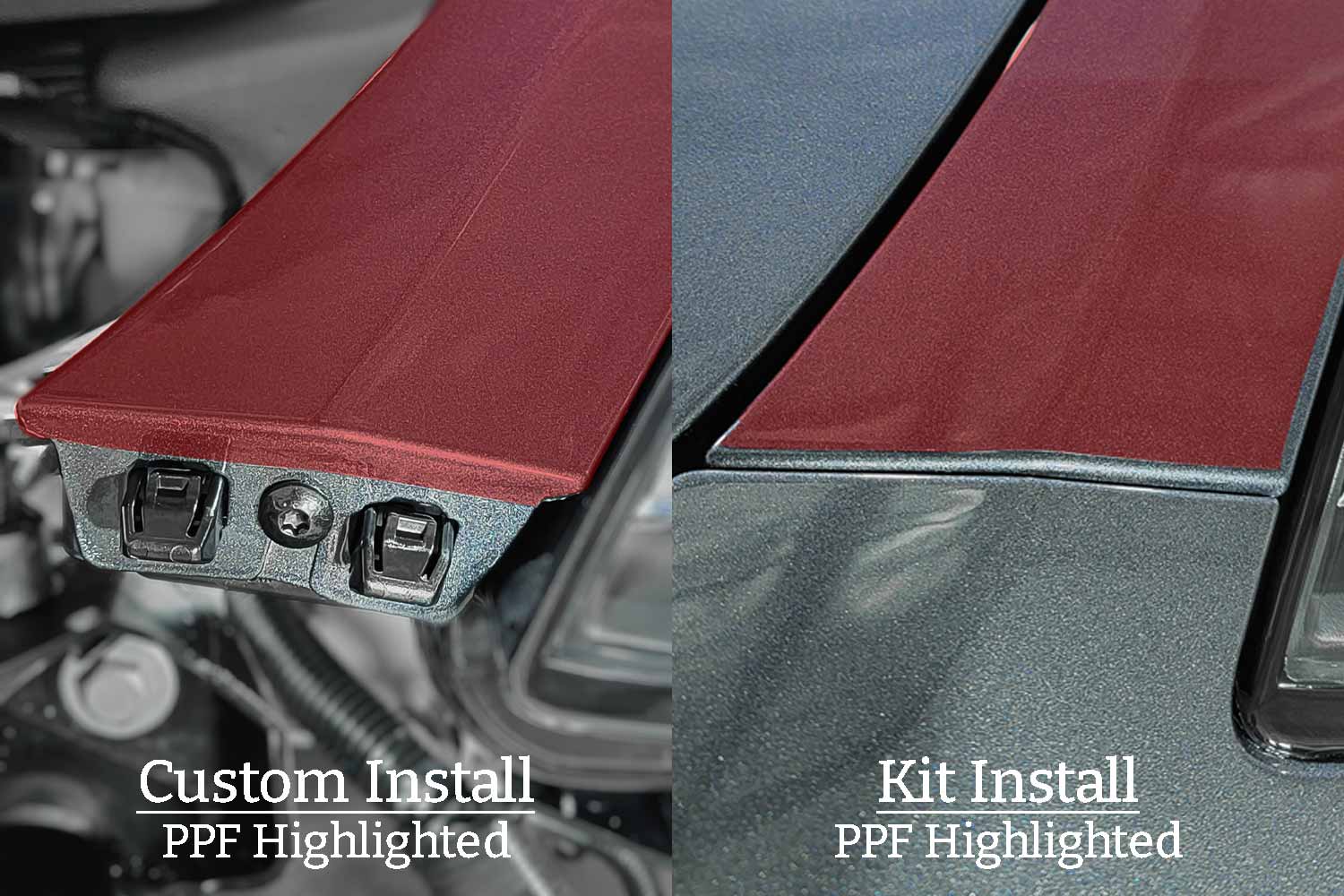
Factors to consider when choosing between the two methods
When deciding between the two methods, consider the following factors:
Coverage:
Determine how much coverage you want for your car's paint. Custom installation may be the best choice if you want comprehensive coverage since it can cover all painted surfaces.
Appearance:
If you want your PPF installation to look as professional and seamless as possible, custom installation is the way to go. If appearance is not a concern, a pre-cut kit may be sufficient.
Cost:
A pre-cut kit may be the best choice if cost is the primary concern. However, if you want the highest level of protection the custom installation is worth the investment.
Car model and modifications:
Consider the make and model of your car and any modifications you have made. Custom installation may be necessary if a pre-cut kit is unavailable or may not fit properly.
Vehicle Color:
If you have a white or lighter paint job on your car, we always recommend going with the Custom PPF Install. On lighter colors, the lines of the Paint Protection Film are more visible. Also, the edges of the film still have a bit of adhesive left over, meaning dirt and debris can accumulate along those lines, creating a dark outline along the lines of the film, and it starts to become an eye sore.
Concluding Thoughts
Our Conclusion & Recommendation
The Kit and Custom PPF installation methods have advantages and disadvantages.
Kit PPF installation is more affordable and quicker, making it an excellent option for those on a budget or with a tight schedule. However, it may not provide the best coverage for complex curves and edges.
A Custom PPF installation, on the other hand, provides superior coverage and protection, especially for high-end vehicles. It also allows for more customization and creativity in design. However, it is more time-consuming.
Consider the coverage you're looking for, expectations for appearance, budget, and even the color of your car. For Southern California car owners, protecting your paint from the salty air and congested highways is essential. Our vehicles are constantly exposed to hazards that damage the paint and decrease their value, so get a quote and ensure your paint stands the test of time.
Whichever installation method you choose, you must ensure you're trusting the right people. Make sure the shop you choose has a reputation of trust and quality. There is always the possibility of damaging a car, and you need someone that will be 100% transparent and take responsibility if an accident does occur.
In conclusion, PPF is an excellent investment for any car owner, regardless of the make and model of the vehicle. Protecting your car's paint from damage will help maintain its value and keep it looking great for years to come.
Please don't wait until it's too late; contact a reputable PPF installer in Southern California today and protect your investment!

